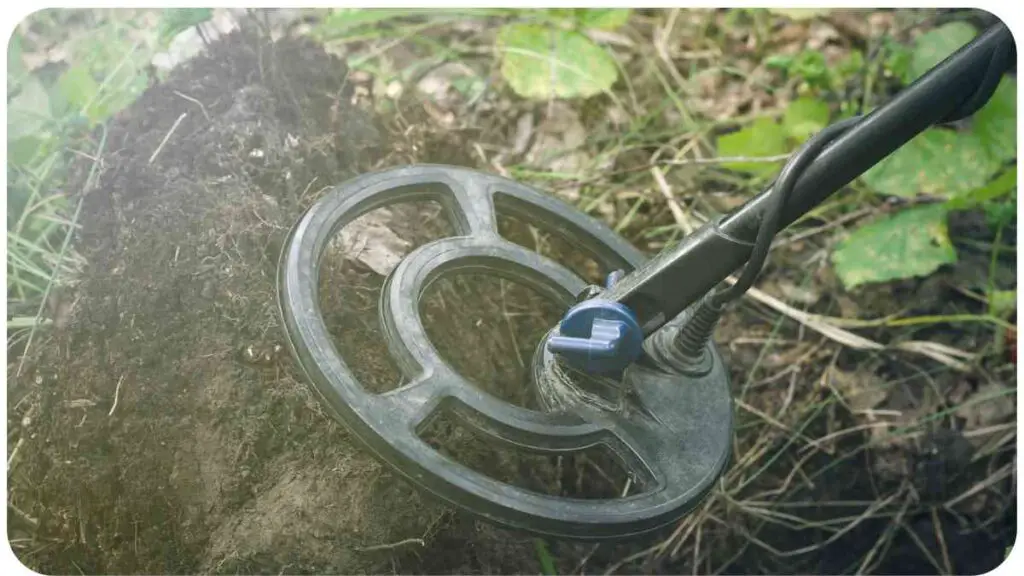Metal detecting has become a popular hobby for treasure hunters, outdoor enthusiasts, and archaeology enthusiasts alike. Whether you’re searching for buried artifacts, lost jewelry, or hidden coins, having the right tools at your disposal can make a significant difference in your success.
While metal detectors are the go-to devices for many, pinpointers have also gained prominence in recent years. In this article, we’ll explore the similarities, differences, and indispensable role of both metal detectors and pinpointers. Weighing the pros and cons of each device will help you decide whether you truly need both tools in your arsenal.
| Key Takeaways |
|---|
| – Metal detectors and pinpointers serve different purposes in metal detecting. |
| – Metal detectors have a broader detection range and are effective for covering larger areas. |
| – Pinpointers are designed for precise target localization and faster recovery. |
| – Pinpointers complement metal detectors by reducing excavation time and minimizing damage to the surroundings. |
| – Both tools can enhance the overall metal detecting experience, but their necessity depends on individual needs and preferences. |
Understanding Metal Detectors
How Metal Detectors Work
Metal detectors work on the principle of electromagnetism. They consist of a control box, a shaft, a search coil, and a stabilizer. When a metal object is detected, the magnetic field created by the metal disturbs the electromagnetic field of the detector, triggering an alert through visual and auditory signals.
For those venturing into the world of treasure hunting, understanding the basics is crucial. Dive deep into the beginner’s guide to metal detecting to equip yourself with the foundational knowledge required to start your journey.
Types of Metal Detectors

There are various types of metal detectors available on the market, but we’ll focus on three main categories: VLF metal detectors, PI metal detectors, and frequency-domain metal detectors.
VLF Metal Detectors
Very Low Frequency (VLF) metal detectors are the most commonly used type. They operate by transmitting and receiving two different frequencies simultaneously. VLF detectors are highly sensitive to small metals and provide discrimination capabilities to filter out undesirable targets.
PI Metal Detectors
Pulse Induction (PI) metal detectors use a single coil that both transmits and receives signals. They’re highly effective in detecting metals in highly mineralized soils, wet sand, and even underwater. PI detectors are known for their depth capabilities and ability to locate larger metal objects.
Frequency-Domain Metal Detectors
Frequency-Domain metal detectors use continuous wave signals at different frequencies to detect metal objects. They are particularly well-suited for prospecting gold and other valuable objects, thanks to their high sensitivity to smaller targets.
As you advance in the world of metal detecting, refining your skills becomes paramount. Glean insights from expert tips and tricks to maximize your metal detecting skills and become a pro at treasure hunting.
Advantages of Using Metal Detectors
Metal detectors offer several advantages when it comes to searching for buried treasures:
- Wide detection range allows for covering larger areas.
- Discrimination features help identify specific metal types.
- Pinpoint mode narrows down the search area for precise retrieval.
- Adjustable sensitivity fine-tunes detection capabilities based on soil conditions.
- Audio and visual cues provide instant feedback to the user.
The Role of Pinpointers
How Pinpointers Work
Pinpointers are handheld metal detecting tools designed to precisely locate the target that a metal detector has signaled. They allow for more accurate and efficient target recovery by reducing the digging area and ensuring minimal damage to the surroundings.
Types of Pinpointers
There are primarily two types of pinpointers available: audio output pinpointers and vibration-based pinpointers.
Embarking on a new hobby can be daunting, especially when there’s so much to learn. Explore how to get started with metal detecting for beginners and begin your adventure on the right foot.
Audio Output Pinpointers
Audio output pinpointers produce a series of beeps and chirping sounds when they are near a metal object. The intensity of the sound or pitch increases as the pinpointer gets closer to the target.
Vibration-Based Pinpointers
Vibration-based pinpointers vibrate when they come in close proximity to a metal object. By feeling the vibrations, users can determine the location of the target accurately.
Advantages of Using Pinpointers
Pinpointers offer several advantages in conjunction with metal detectors:
- Precise target localization to minimize digging efforts.
- Faster target retrieval without disturbing nearby soil.
- Increased accuracy when digging in locations with limited space.
- Improved recovery time by reducing the number of false alarms.
Metal Detector vs. Pinpointer: Key Differences
When considering metal detectors and pinpointers, various aspects differentiate the two tools. Let’s explore some of the key differences:
Purpose and Functionality
Metal detectors serve the purpose of detecting and identifying metal objects within a wide range. They are effective in covering larger areas and can discriminate between different types of metals.
On the other hand, pinpointers are designed specifically to locate and precisely pinpoint the exact location of a metal target once it has been detected by a metal detector. They help in narrowing down the search area, making target recovery more efficient and accurate.
With countless options in the market, choosing the right equipment is often overwhelming. Refer to the top 15 best metal detectors for beginners to make an informed decision tailored to your needs.
Detection Range and Accuracy
Metal detectors typically have a larger detection range compared to pinpointers. They can detect metal objects at greater depths and cover a wider area in a single sweep.
Pinpointers, on the other hand, have a limited detection range and are more focused on providing precise location information once the target has been detected. The accuracy of pinpointers is higher, as their purpose is to pinpoint the exact location of the target with precision.
Size and Portability
Metal detectors are generally larger and bulkier due to their design and functionality. They consist of a control box, a shaft, and a search coil, which can make them less portable and more cumbersome to carry around.
Pinpointers, on the other hand, are compact and handheld, making them highly portable and easy to carry. Their smaller size allows for greater maneuverability in tight spaces and makes them convenient for quick target recovery.
Target Recovery Time
Metal detectors are effective for covering larger areas and quickly detecting metal objects. However, their target recovery time can be slower compared to pinpointers. Once a metal object is detected by a metal detector, pinpointers come into play by providing precise location information, reducing the time and effort required for excavation. Pinpointers allow for faster and more efficient retrieval of targets.
Do You Need Both?
While both metal detectors and pinpointers have their unique roles and advantages, the question remains: do you really need both tools? It depends on your specific needs, preferences, and the type of metal detecting activities you engage in.
Pros and Cons of Using Both Devices

Using a metal detector alone provides a comprehensive approach to metal detecting. It allows you to cover larger areas and detect a wide range of metal objects. Metal detectors have adjustable sensitivity settings and discrimination features, which enable you to filter out unwanted targets and focus on valuable finds. They are especially useful for general-purpose metal detecting.
On the other hand, pinpointers offer precise target localization and faster target recovery. They are indispensable in scenarios where accuracy and efficiency are essential, such as in tight spaces, dense environments, or when searching for specific targets. Pinpointers complement metal detectors by reducing dig time, minimizing damage to the surroundings, and increasing overall recovery success.
Deciphering the signals of your metal detector can sometimes feel like learning a new language. Delve into understanding your metal detector’s signals with these tips and tricks and become fluent in the art of detection.
Factors to Consider When Deciding
When deciding whether you need both devices, consider the following factors:
- Budget: Metal detectors are typically more expensive than pinpointers. Assess your budget and invest in the tool that aligns with your financial capabilities.
- Type of Metal Detecting: Evaluate the type of metal detecting activities you engage in. If you primarily focus on open areas or wide terrains, a metal detector may be sufficient. However, if you often find yourself in tighter spaces, searching for small or valuable targets, or needing precise location information, then a pinpointer becomes a valuable addition.
- Skill and Experience Level: Beginners to metal detecting might find using a metal detector alone to be more straightforward and manageable. As you gain experience and expertise, incorporating a pinpointer can enhance your efficiency and success rate.
- Personal Preferences: Consider your own preferences and tendencies. Some individuals may enjoy the thrill of searching with a metal detector and then carefully pinpointing the target manually, while others prefer the speed and accuracy of using a pinpointer from the start.
Ultimately, the choice depends on your individual needs and circumstances. Some metal detector enthusiasts find that investing in both tools enhances their overall metal detecting experience.
Tips for Effective Metal Detecting
To ensure the best results while using metal detectors and pinpointers, consider the following tips:
- Research and Familiarize: Understand your metal detector and pinpointer thoroughly. Read the user manuals, watch tutorial videos, and practice using the devices to maximize their potential.
- Ground Balance: If your metal detector has ground balance capabilities, take the time to ground balance properly for optimal performance, especially in highly mineralized or challenging soil conditions.
- Calibration: Regularly calibrate your metal detector to ensure accurate and reliable detection. Follow the manufacturer’s instructions for calibration procedures.
- Explore Different Modes: Experiment with different modes and settings on your metal detector to cater to varying target types and conditions. Adjust sensitivity levels and discrimination settings to suit your preferences and environment.
- Maintain a Methodical Approach: While searching, maintain a slow and steady pace to ensure thorough coverage of the area. Overlapping sweeps and systematic grid patterns can help ensure no targets are missed.
- Dig Responsibly: When retrieving targets, dig carefully and responsibly. Use a small hand trowel or digging tool to minimize damage to the surrounding area. Fill any holes created during excavation and leave the area as you found it, following the principles of Leave No Trace.
- Learn from Experience: As you gain more experience and spend time detecting, you’ll develop a better understanding of your metal detector’s signals and the nuances of different environments. Pay attention to the feedback you receive from your device and learn from each detecting session.
- Connect with the Metal Detecting Community: Engage with other metal detector enthusiasts online or in-person to share tips, experiences, and learn from each other. Join metal detecting forums, attend meetups, or participate in local clubs to connect with like-minded individuals.
Remember, metal detecting is not just about the finds but the joy of exploration and the thrill of discovery. Embrace the journey and savor the stories that come along the way.
Conclusion
Metal detectors and pinpointers are essential tools for any serious metal detecting enthusiast. While metal detectors cover a broader range and detect a variety of metals, pinpointers provide accurate target localization and fast recovery. The decision to use both devices depends on your specific needs, budget, and metal detecting activities.
Understanding the differences between metal detectors and pinpointers is crucial to make an informed choice. Consider factors such as detection range, accuracy, portability, and recovery time when deciding which tool to invest in.
Ultimately, both metal detectors and pinpointers serve their unique purposes and can complement each other. The key is to strike a balance that maximizes your efficiency, success rate, and enjoyment while metal detecting. With practice, experience, and a passion for the hobby, you’ll uncover hidden treasures and create unforgettable memories. Happy hunting!
Further Reading
Here are some additional resources that provide more information on the topic of metal detectors and pinpointers:
Metal Detector vs. Pinpointers – 911 Metallurgist: This article explores the differences and advantages of using metal detectors and pinpointers, helping you understand their respective roles in metal detecting.
Metal Detecting Pinpointer Guide – Metal Detecting Tips: This comprehensive guide dives into the features and benefits of pinpointers, providing valuable insights on how to choose and use them effectively.
Can You Metal Detect with Just a Pinpointer? – Diggers and Detectors: This article discusses the viability of using only a pinpointer for metal detecting activities, providing useful information and considerations for those interested in this approach.
FAQs
Here are some frequently asked questions about metal detectors and pinpointers:
Can I use a pinpointer without a metal detector?
Yes, pinpointers can be used independently for metal detecting, but they are most effective when used in conjunction with a metal detector. Metal detectors provide a wider detection range, while pinpointers allow for accurate target localization and faster recovery.
Can a metal detector replace a pinpointer?
Metal detectors can detect and identify metal objects over a larger area, but they may not provide the same level of precision as a pinpointer when it comes to pinpointing the exact location of a target. Pinpointers are specifically designed for precise target recovery and are highly recommended as complementary tools to metal detectors.
Do all metal detectors have pinpointing capabilities?
Not all metal detectors have pinpointing capabilities built into them. Pinpointing capabilities are a specific feature found in some metal detector models, which allow users to narrow down the search area for more accurate target recovery. However, even if a metal detector lacks built-in pinpointing capabilities, an external pinpointer can still be used for more precise localization.
Are pinpointers waterproof?
Many pinpointers on the market today are waterproof or water-resistant to varying extents. Some pinpointers are completely submersible, allowing for underwater metal detecting. However, it’s crucial to check the specifications of the pinpointer to determine its water resistance capabilities before using it in wet or submerged environments.
How do I choose the right pinpointer for my needs?
When choosing a pinpointer, consider factors such as detection range, waterproofing, sensitivity, durability, battery life, and user-friendly features. It’s also important to read reviews and consider the experiences of other metal detector enthusiasts to make an informed decision.

Hi there! My name is Hellen James, and I’m here to talk to you about treasure hunting. I’ve been a fan of treasure hunting ever since I was a kid, and if you’re a fan of treasure hunting or just like the idea of finding a long-lost fortune, then this blog is for you.

